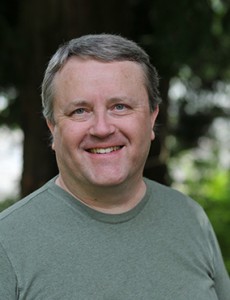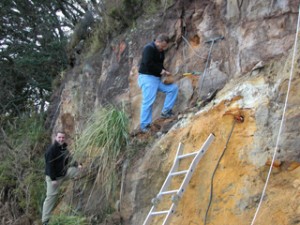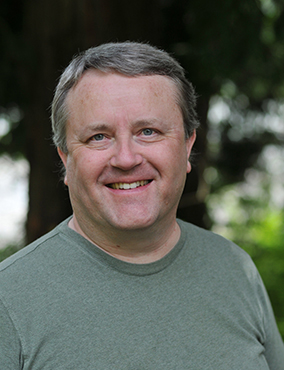Who’s who in Science…
 Dr. Olav Lian joined UFV’s Geography Department in Spring 2004 and began teaching in January 2005 teaching courses in Physical Geography, a Major option in the Bachelor of Science program.
Dr. Olav Lian joined UFV’s Geography Department in Spring 2004 and began teaching in January 2005 teaching courses in Physical Geography, a Major option in the Bachelor of Science program.
Interview:
Personal
I was born in Vancouver, and grew up in North Vancouver near Seymour Provincial Park, where I went to high school and completed my first two years of university close to home at Capilano College. After some time away from university to work, I transferred my courses to Simon Fraser University (SFU) to complete my BSc in physics. Growing up beside the Coast Mountains, and a provincial park, provided me with plenty of opportunities for hiking and exploring the backcountry, and it was by doing this that I gained a keen interest in earth sciences. While an undergraduate student at SFU, one of my physics instructors, Prof. David Huntley, asked me if I would like a summer job as a research assistant in his laboratory. It was that opportunity that changed my life. Huntley and his research group had just invented a technique that could be used to measure the time elapsed since mineral (sand) grains were last exposed to sunlight. The technique, which he called ‘optical dating’, could therefore be used to date when sedimentary landforms had developed; knowledge of this is important to earth scientists who are studying the evolution of the earth’s surface. My taste of research in the SFU physics department, together with my keen interest in earth sciences, made me decide to pursue an MSc in physical geography (also at SFU), where I applied some of the techniques I had learned working for Prof. Huntley. After my MSc I completed a PhD in geology at University of Western Ontario, which was followed by a postdoctoral research position in geology at Victoria University of Wellington in New Zealand where I helped build New Zealand’s first optical dating laboratory. After that I returned to SFU physics and worked as a research associate with Prof. Huntley. Very early in 2002 I moved to England to take up a permanent (tenured) faculty position in the geography department at Royal Holloway, University of London, where I directed their geochronology laboratory which included a state-of-the-art optical dating facility. This was an amazing time for me as I was part of one of the best geography departments in the UK, which involved a strong science-based research and teaching component. Despite the benefits of working at Royal Holloway, and being close to some of the best universities in the world, I felt I had to leave London as the high cost of living in the area made life too difficult.
UFV Life
In December 2003 A colleague of mine in the Geography Department at UFV (then UCFV), who I had attended graduate school with at SFU, told me that there was going to be some retirements in his department and that I should keep my eyes open for job postings. He also told me that UCFV was lobbying hard to get full university status, and that as such UCFV might be a good fit for me. I did not really know anything about UCFV at the time, but the prospect of helping build a new university, moving back to British Columbia, and increasing my standard of living, was appealing. I applied for a position and was interviewed in spring 2004; I arrived at UCFV in January 2005. The years leading up to 2008, the year UCFV became UFV, seems to me to have been a much more positive and forward-looking time. I was able to convince senior management that UFV should build me a research laboratory (The Luminescence Dating Laboratory), which would allow me to attract external funding and establish a small but productive research group. Over the years this has worked well, and I have employed and mentored many undergraduate students as research assistants and researchers. I have also been able to support a modest number of graduate students, which I supervise through my adjunct professorships at SFU and UVic, and recently a UFV-based postdoctoral fellow. My role in my department is to teach a handful of courses in physical geography, manage and direct the Luminescence Dating Laboratory, make sure that our research is published in peer-review journals, secure external funding, and mentor research students. The year after I was hired, my department hired J Hughes, a palaeoecologist, and a research laboratory was built for him as well; I think it was the last purpose-built faculty-directed science research laboratory built at UFV.
Teaching
You asked if I had always known that I wanted to teach. The answer is “no”. I started teaching, as many of us do, as a teaching assistant during graduate school to earn some money. I taught my first course as an instructor (with my own teaching assistant) the year after I had finished my MSc: My former MSc supervisor was going on leave and he had asked me if I would like to teach his third-year course. I hesitated because I wasn’t sure that lecturing in front of 50+ students twice a week was something that I would like, but I thought that it was something that I had better try in order to gain experience, in case I was to end up in academia. The first class I ever taught was nerve-racking, but it quickly got easy, and then I began to like it. I did not have to teach during my tenure in New Zealand, but had a full teaching load, both undergraduate and graduate courses, at Royal Holloway. At Royal Holloway our research was closely tied to our undergraduate teaching. If a faculty member resigned, the courses he or she taught likely disappeared as well, as the person that was subsequently hired was expected to teach new courses within their expertise, as defined by their research. For that reason we did not use textbooks. This is different to the style in Canada where faculty teach a greater variety of courses, and sometimes, especially at institutions like UFV that have small departments, courses significantly outside of their direct academic experience. Textbooks and other forms of secondary information therefore are often relied on. It was hard for me to return to that system, but luckily I am able to teach at UFV only courses that are related to the fields encompassed by my research program. The courses I teach at UFV are in geomorphology and Quaternary geology. I enjoy all of the courses I teach, from first year to fourth year, but the one I enjoy the most is my fourth year course in Quaternary geology. The topics covered in that course are most closely linked to my research, and/or to that of the colleagues that I publish with. I teach that course biennially and as such it evolves as new research is published, and much of that research involves my own. My students are also introduced to several of my collaborators at other universities and government institutions, and graduate students (some who were my former undergraduates at UFV), who talk to them (and hopefully inspire them) about their research and careers. My fourth year course also serves as a place to find keen undergraduate research assistants. As for advice to current students, I would say take full advantage of opportunities available university. There is much more to it than learning in a classroom, studying, and writing exams. Students should talk to professors about their inspirations, and show initiative. Sometimes this generates valuable learning, training, and networking opportunities outside of the classroom, or indeed outside of the institution.
Research
I am involved in a great deal of r esearch, and it’s very important to me. I have been doing my best to keep my research pace close to what it was before coming to UFV, in order to stay competitive for external funds and maintain valuable collaborations. It has sometimes been a challenge. Most of the research conducted by my team is related to how the earth’s surface has responded to long-term environmental change, such as that associated with the coming and going of ice ages. Almost all of my research has a strong field component and this has allowed me to visit some interesting places, from the Canadian Arctic (east and west) to Haida Gwaii, to the prairies; from New Zealand and Australia to southern Chile and Argentina, and many other places. I have been fortunate to have attracted external funding that allows me to take research students to most of these places. Currently, most of my research, and that of my UFV team, is focussed along the central coast of British Columbia and is in collaboration with the Hakai Institute, and colleagues from UVic, SFU, UNBC, and other institutions. Our role is to help understand the geologic history of our central coast and how it relates to the arrival of first peoples in the region, which involves exciting collaboration with archaeologists. You asked if my research falls within UNESCO’s “International Year of Light and Light-Based Technologies”. It does indeed. In fact, it coincides with the 30-year anniversary of the invention of optical dating, a light-based technology which has revolutionized our understanding of the evolution of the earth’s surface. This connection was mentioned, and celebrated, in a recent ‘News & Views’ article in the journal Nature that I co-authored.
esearch, and it’s very important to me. I have been doing my best to keep my research pace close to what it was before coming to UFV, in order to stay competitive for external funds and maintain valuable collaborations. It has sometimes been a challenge. Most of the research conducted by my team is related to how the earth’s surface has responded to long-term environmental change, such as that associated with the coming and going of ice ages. Almost all of my research has a strong field component and this has allowed me to visit some interesting places, from the Canadian Arctic (east and west) to Haida Gwaii, to the prairies; from New Zealand and Australia to southern Chile and Argentina, and many other places. I have been fortunate to have attracted external funding that allows me to take research students to most of these places. Currently, most of my research, and that of my UFV team, is focussed along the central coast of British Columbia and is in collaboration with the Hakai Institute, and colleagues from UVic, SFU, UNBC, and other institutions. Our role is to help understand the geologic history of our central coast and how it relates to the arrival of first peoples in the region, which involves exciting collaboration with archaeologists. You asked if my research falls within UNESCO’s “International Year of Light and Light-Based Technologies”. It does indeed. In fact, it coincides with the 30-year anniversary of the invention of optical dating, a light-based technology which has revolutionized our understanding of the evolution of the earth’s surface. This connection was mentioned, and celebrated, in a recent ‘News & Views’ article in the journal Nature that I co-authored.
Links:
More about Dr. Lian: ufv.ca/geography/faculty-and-staff/faculty-members/lian-olav.htm
Luminescence Dating Laboratory: ufv.ca/geography/research/luminescence-dating-laboratory/
ufv.ca/science
The opinions expressed in this article are the author’s own and do not necessarily reflect the views of the Faculty of Science.

